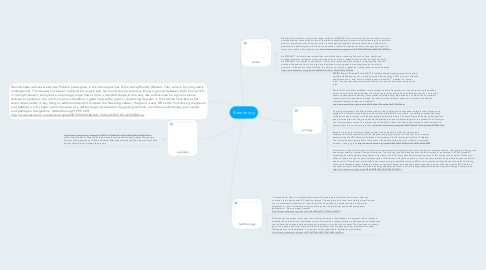Biomimicry
by Jordan Nesseth

1. Round shape reduces water loss"Pebble plants grow in the stonier patches of the same [Namib] [D]esert. They survive by living partly underground. Their leaves have been reduced to a single pair, fat, round and succulent, with just a groove between them from which, in the right season, will sprout a surprisingly large flower. Such a rounded shape, with a very low surface area for a given volume, reduces evaporation to a minimum and is therefore a great help to the plant in conserving its water in the intense heat. But as has been noted earlier it may bring an additional benefit. Outside the flowering season, the plant is very difficult to find among the gravel and pebbles, so its shape could also serve as a defence against detection by grazing animals -- ostriches and tortoises, porcupines and perhaps a few gerbils." (Attenborough 1995:265) http://www.asknature.org/strategy/aa6e84f7949282b064bb13b83dc586f1#.UwZb5GRDvuc
2. trade
2.1. BioPower has created a wave power system called bioWAVETM. Each unit is mounted on the seafloor. A pivot near the seafloor converts the motion of the three floating blades and stem to electrical energy via an onboard power conversion module. The wave motion is converted into hydraulic pressure that spins a turbine which generates the electricity that is fed to shore via subsea cables. This design can harness energy from dynamic waves and exhibit robust performance. http://www.asknature.org/product/7fb15ff64573cfbde3359873d800274a
2.2. bioSTREAM™ is a tidal power system that mimics thunniform swimming fish such as tuna, sharks, and mackerel. However, instead of moving through water as they do, sweeping their caudal fins back and forth, bioSTREAM™ is anchored to the bottom. There, it can rotate with the incoming or outgoing tide, and the energy in the passing flow is used to drive the device motion against the resisting torque of an electric generator. In the event of extreme flows, the device can assume a streamlined configuration to avoid damage. http://www.asknature.org/product/a3676b91b1431c1727ab8517d1575f5e
3. energy
3.1. REGEN Energy™ created EnviroGrid™, a wireless energy management solution that is quickly installed and can cut a property owner’s electric costs 5-10% or more—often the equivalent of one "free" electric bill every year. EnviroGrid™ is based on "swarm logic," the way that bees communicate and coordinate with each other using simple rules. EnviroGrid™ controllers establish a mesh wireless network. The devices communicate among themselves autonomously. Using their algorithm, the devices spread out energy demand between devices. The result is known as peak demand shaving. Many utilities calculate billing rate based on a combination of maximum consumption and peak demand usage. By reducing peak demand usage and smoothing out demand, substantial energy savings can be realized. http://www.asknature.org/product/b2bf9d9da17beacbbe34a7359f376bc6
3.2. During photosynthesis, the light reactions result in the splitting of a neutral water molecule into hydrogen and oxygen. This biochemical pathway is quite complex and difficult to reproduce. In addition to untangling these multielectron photoreactions, the Nocera group demonstrated Proton-Coupled Electron Transfer using superfast lasers for measurement. The group has since developed a suite of photocatalysts for the production of hydrogen from diverse water sources. The company Sun Catalytix has been founded to advance these achievements and develop them into commercial products. http://www.asknature.org/product/071e2f1a71bc7ba9cae6ab7f70847ce6
3.3. Based on the way the flamingo, Phoenicopterus ruber, feeds, BiomiVal has developed a bidirectional turbine that can profit from the great energy that comes from the sea. It's now being developed by the UPV (Valencian Politechnic University) and the Technological Institute of Valencia. The first scaled prototypes allow a comparison with existing technologies and show an interesting increase of energy profit. http://www.asknature.org/product/853709a36919ecbb21b4733094340959
3.4. Solar Botanic is the first company to introduce a new dimension of cost reduction by combining two energy resources, solar and wind energy, into one system based on nature's design–biomimicry. The surface of the Earth receives solar radiation energy at an average of 81,000 terawatt – exceeding the whole global energy demand by a factor of 5,000. Plants have been harnessing some of this energy with maximum efficiency for billions of years through the photosynthetic cycle of their leaves. Solar Botanic plans to mimic the same process using electromagnetic collectors also known as “Nantennas”, which offer lower-costs and improved efficiency (up to 92%) over conventional silicon-based solar cells. Continuing advances in electromagnetic collectors will have a significant impact by increasing output, reducing costs per kWh and improve ROI (return on investment) of solar/wind-based renewable energy deployments, both of which are key challenges facing the renewable energy industry today. http://www.asknature.org/product/f0efe88ff818b542a13f35826cfd3273
4. technology
4.1. "Konarka Power Plastic is a photovoltaic material that captures both indoor and outdoor light and converts it into direct current (DC) electrical energy. This energy can be used immediately, stored for later use, or converted to other forms. Power Plastic can be applied to a limitless number of potential applications – from microelectronics to portable power, remote power and building-integrated applications." (from company website) http://www.asknature.org/product/a21fcbc8ff5a053c793164e3fdffc249
4.2. The Aquaporin company is focusing on mimicking the ability of lipid bilayers in biological cells to transport water back and forth across membranes by way of membrane channel proteins called aquaporins. Aquaporins can facilitate this transport while excluding any particles or ions that are not water. The Aquaporin company's goal is to create a new class of water filtration membranes that use aquaporins as cornerstones in water filtering devices to be employed in industrial and household water filtration and purification. http://www.asknature.org/product/c70bbf7fb3ad4097b961d686cca053ea
5. evolved
5.1. http://www.asknature.org/strategy/c35537c7c19c6b8b411f7df46c68d29f#.UwZZUmRDvuc plants have evolved so they can now go a very long time without having water. They can go almost all the way gone and still be surviving. After they are really low the water will come back and the leaf will be completely thing again.


